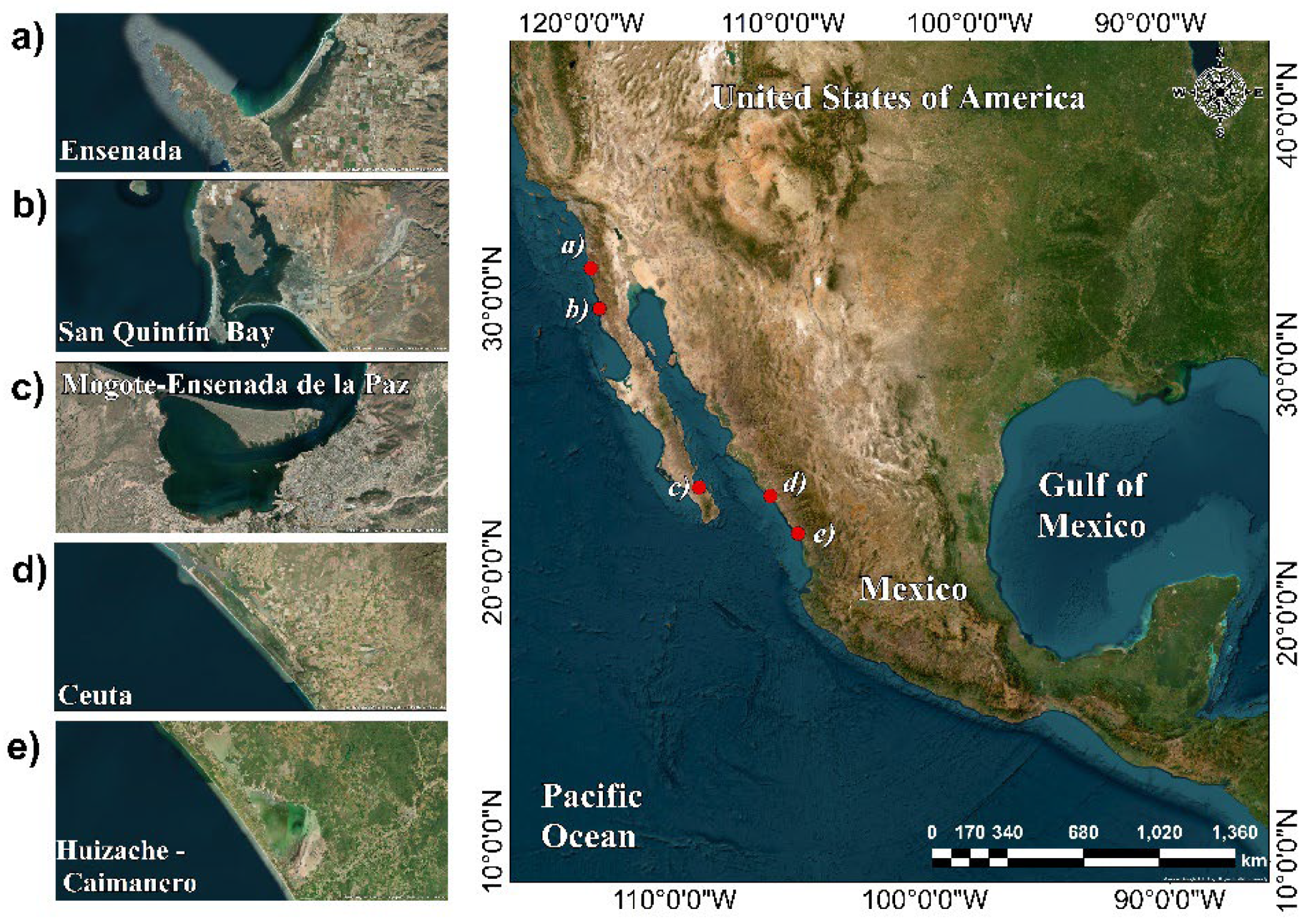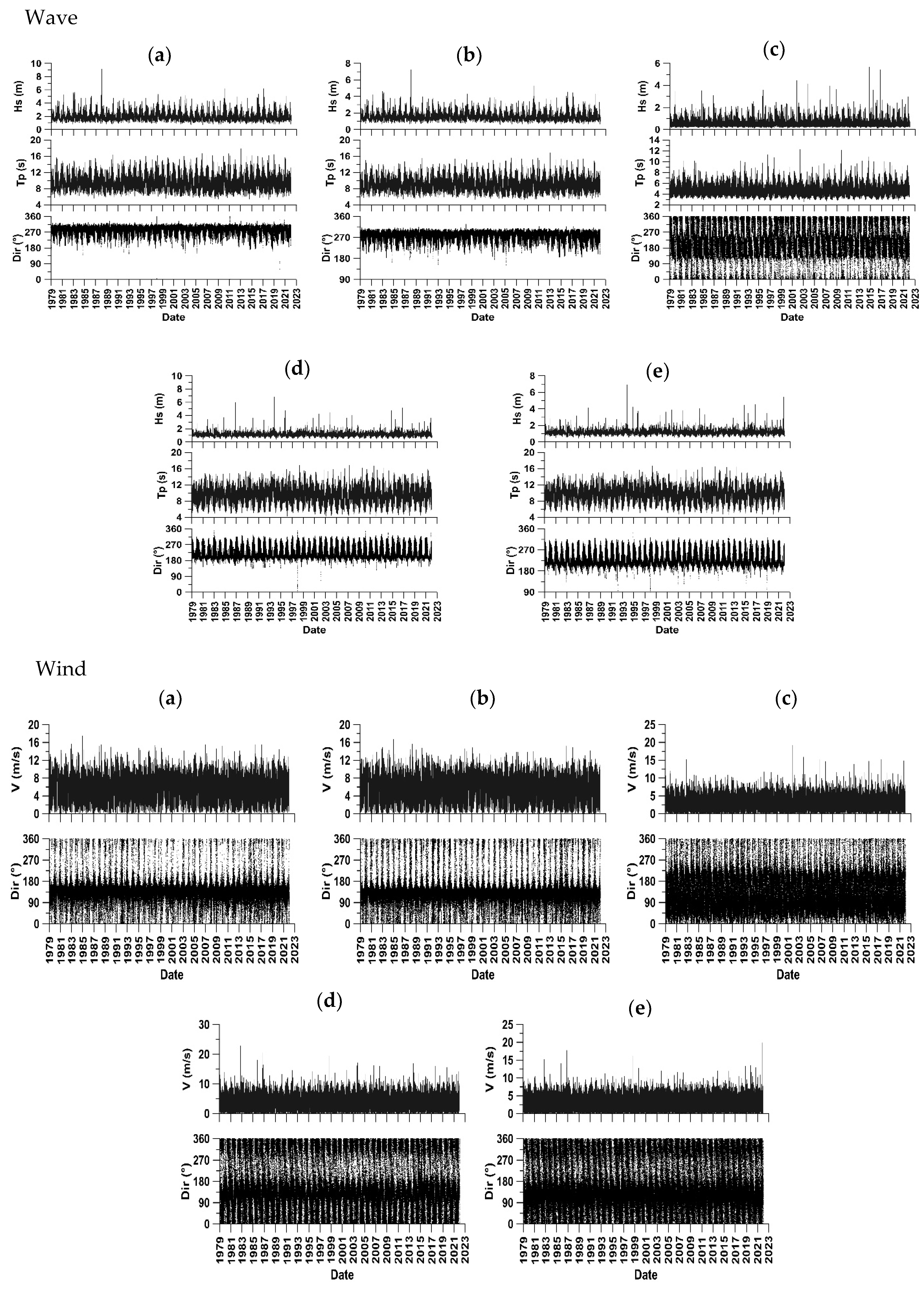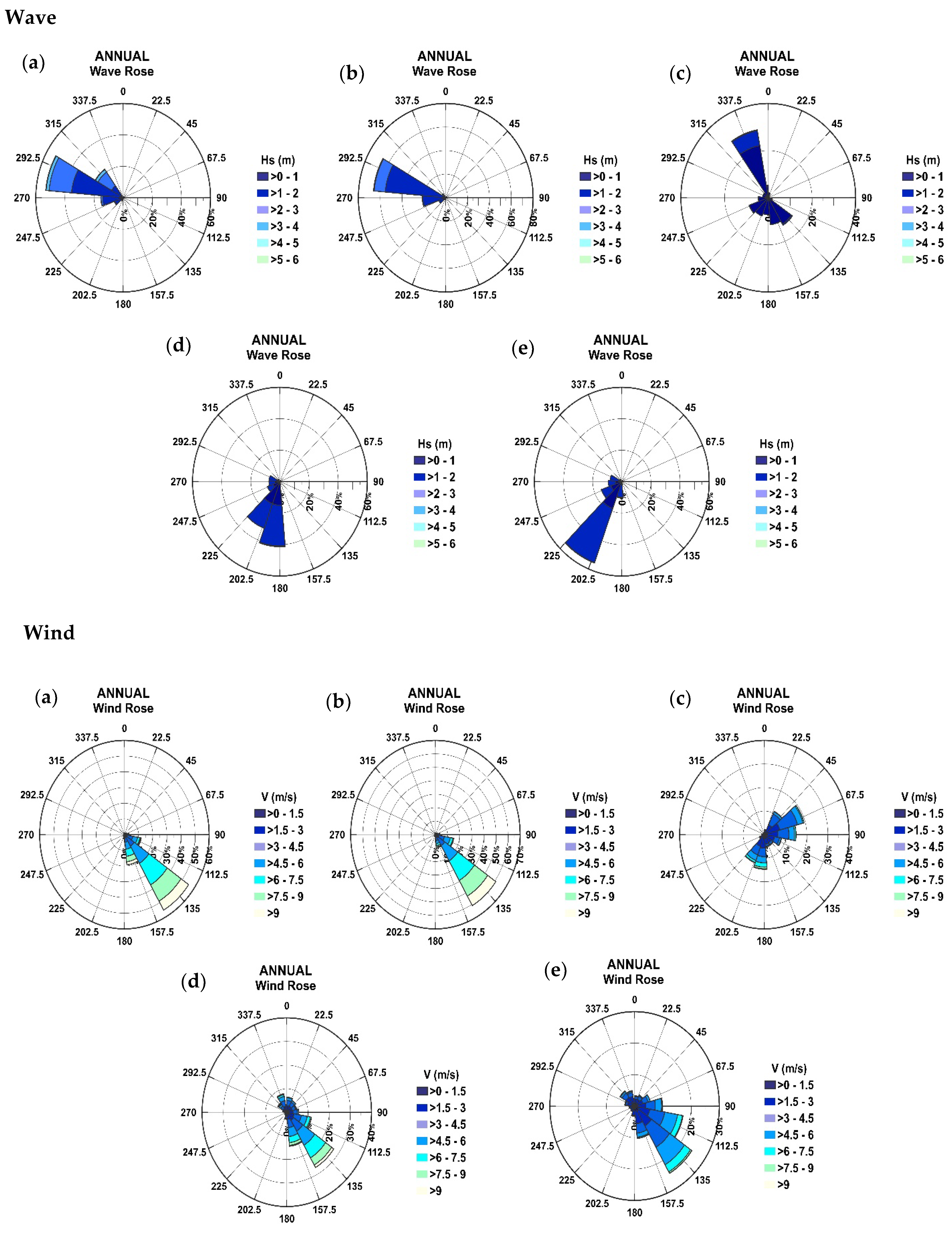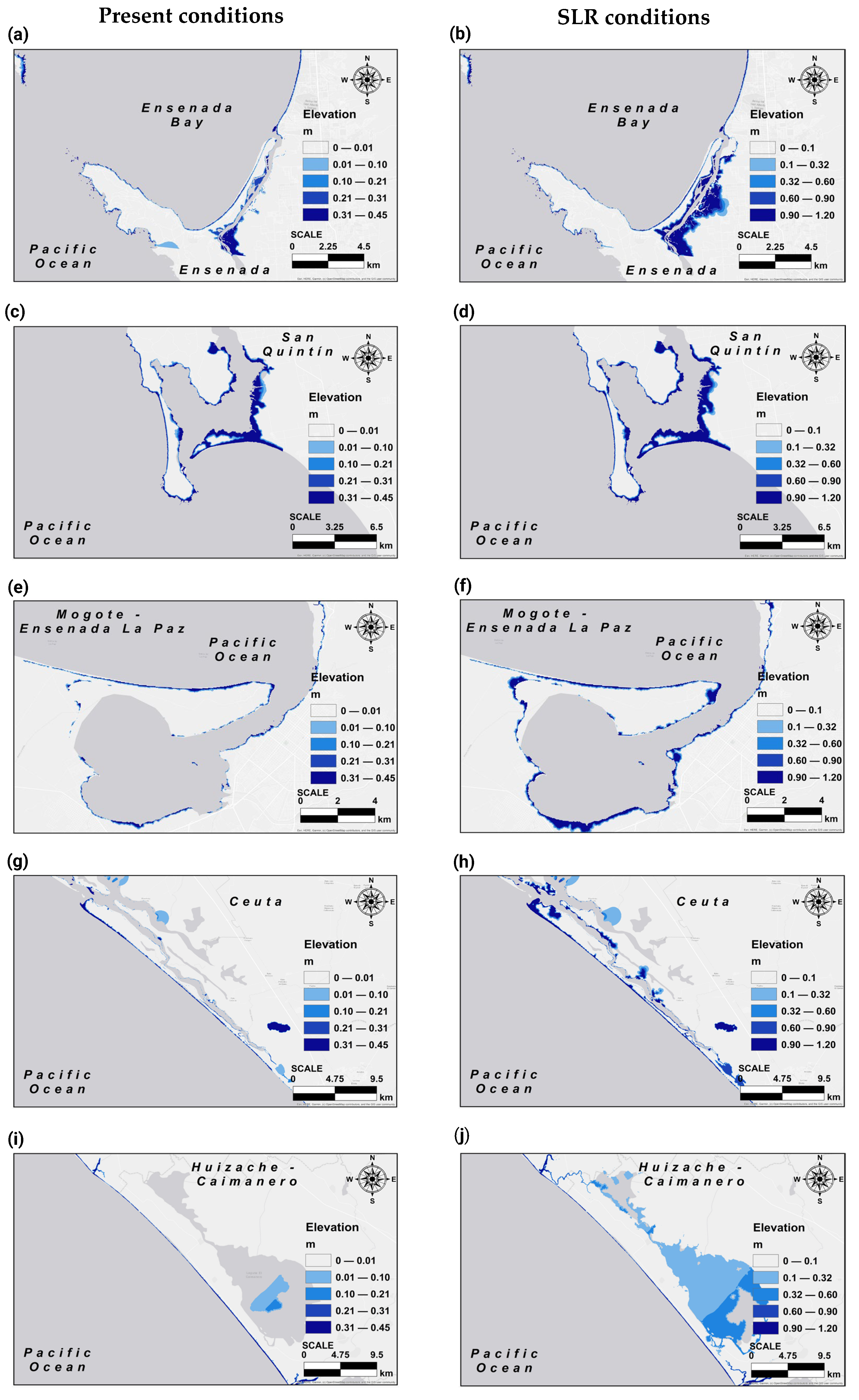Effects of Sea Level Rise on Hydrodynamics and Spatial Variation in Mexican Coastal Wetlands Along the Pacific Americas Flyway
Abstract
1. Introduction
2. Materials and Methods
2.1. Study Area
- (a)
- Punta Banda estuary (Ramsar Site number 1604): Located 13 km south of the urban area of Ensenada, it presents a variety of intertidal marshes, mudflats, and seagrass meadows protected by a sandy bar that separates the body of water from the ocean. The Punta Banda estuary is a priority site for conservation at the state and national level due to its high presence of endemic species, its specific species richness, and its great functional importance as a center of origin and natural diversification. It is also a Site of Regional Importance in the Western Hemisphere Shorebirds Reserve Network (WHSRN) and a Mexican Important Bird Area (IBA, or AICA in Spanish No. 103) category 5, that is, an area where ornithological research work is relevant for bird conservation at a global level [47].
- (b)
- San Quintín Bay (Ramsar Site number 1775): It is located 180 km south of the city of Ensenada and is the largest and most important coastal wetland in Baja California. It consists of a coastal lagoon and a coastal plain, with marshes and seagrass beds that constitute one of the most important wintering sites (refuge and feeding sites) for a high population of migratory birds, among which the black branta (Branta bernicla nigricans) stands out. Due to its characteristics, this wetland is considered rare or uncommon for the Californian biogeographic region, in addition to being home to populations of various species of threatened and endangered birds and being the only place in Baja California where black chicks (Laterallus jamaicensis), a relevant and endangered species, have been sighted. San Quintín Bay is a WHSRN Site of Regional Importance and AICA No. 102 [48].
- (c)
- Mogote—Ensenada La Paz (Ramsar Site number 1816): It is a coastal lagoon separated from the La Paz Bay by a sand barrier (El Mogote). The mangroves of Ensenada La Paz have floodplains and internal water bodies, creating small lagoons that are important nesting, breeding, and rest areas for many bird species, with most of them under special legal protection. In total, 37% of the bird species are migratory, and on their journey south, they stop in to eat and rest during the winter season. Ensenada La Paz is recognized by at least three more distinctions: 1) a WHSRN Site of Regional Importance; 2) Priority Wetland for Shorebirds in Mexico (No. 20); and 3) AICA No. 93 category G-1 (Global) [49].
- (d)
- Ceuta coastal system lagoon (Ramsar Site number 1824): This system is formed by several lagoon complexes and marshes and has an important extension of mangrove vegetation. Due to its characteristics, diversity, and abundance of bird species, it is considered a WHSRN Site of Regional Importance and AICA No. 247. This system supports huge populations of shorebirds, such as Calidris mauri, Phalaropus tricolor, Recurvirostra americana, Charadrius alexandrinus, and Sterna maxima, where the intertidal influence plays a fundamental role in the conservation of migratory shorebirds. The site is also found under the sanctuary category at a national level [50].
- (e)
- Huizache—Caimanero coastal lagoon (Ramsar Site number 1689): located in the southeastern part of the Gulf of California, the site consists of a series of wetlands, ranging from coastal and continental to artificial. Due to its location along the PAF, it is a site of high importance for migratory birds in Mexico, including the American White Pelican (Pelecanus erythrorhynchus) and the Roseate Spoonbill (Ajaia ajaia). It is a WHSRN Site of Regional Importance and AICA No. 147. The riverside of the lagoon mainly constitutes mangrove forests (red, black, and white mangroves). According to the IUCN Protected Area Categories, the site belongs to Category IV and is under the federal jurisdiction of the National Water Commission of Mexico [51].
2.2. Topobathymetric Survey
2.3. Wave and Wind Conditions
2.4. Sea Level Rise Projection and Tidal Levels
2.5. Model Setup
3. Results
3.1. Effects of Sea Level Rise on Wetlands’ Coastal Currents Field
3.2. Effects of Sea Level Rise on Land Extension Flooding
4. Discussion
5. Conclusions
Author Contributions
Funding
Data Availability Statement
Acknowledgments
Conflicts of Interest
References
- Fox-Kemper, B.; Hewitt, H.T.; Xiao, C.; Aðalgeirsdóttir, G.; Drijfhout, S.S.; Edwards, T.L.; Golledge, N.R.; Hemer, M.; Kopp, R.E.; Krinner, G.; et al. Ocean, Cryosphere and Sea Level Change. In Climate Change 2021: The Physical Science Basis. Contribution of Working Group I to the Sixth Assessment Report of the Intergovernmental Panel on Climate Change; Masson-Delmotte, V., Zhai, P., Pirani, A., Connors, S.L., Péan, C., Berger, S., Caud, N., Chen, Y., Goldfarb, L., Gomis, M.I., et al., Eds.; Cambridge University Press: Cambridge, UK; New York, NY, USA, 2021; pp. 1211–1362. [Google Scholar]
- Singer, M.N.; Cavalcante, G.H.; Atabay, S. Hydrodynamic Modeling of Sharjah Lagoons under Climate Changes, United Arab Emirates (UAE). Reg. Stud. Mar. Sci. 2023, 63, 102995. [Google Scholar] [CrossRef]
- IPCC Summary for Policymakers. In Climate Change 2023: Synthesis Report. Contribution of Working Groups I, II and III to the Sixth Assessment Report of the Intergovernmental Panel on Climate Change; Core Writing Team, Lee, H., Romero, J., Eds.; IPCC: Geneva, Switzerland, 2023; pp. 1–34. [Google Scholar]
- Vitousek, S.; Barnard, P.L.; Fletcher, C.H.; Frazer, N.; Erikson, L.; Storlazzi, C.D. Doubling of Coastal Flooding Frequency within Decades Due to Sea-Level Rise. Sci. Rep. 2017, 7, 1399. [Google Scholar] [CrossRef] [PubMed]
- Klingbeil, B.T.; Cohen, J.B.; Correll, M.D.; Field, C.R.; Hodgman, T.P.; Kovach, A.I.; Lentz, E.E.; Olsen, B.J.; Shriver, W.G.; Wiest, W.A.; et al. High Uncertainty over the Future of Tidal Marsh Birds under Current Sea-Level Rise Projections. Biodivers. Conserv. 2021, 30, 431–443. [Google Scholar] [CrossRef]
- Von Holle, B.; Irish, J.L.; Spivy, A.; Weishampel, J.F.; Meylan, A.; Godfrey, M.H.; Dodd, M.; Schweitzer, S.H.; Keyes, T.; Sanders, F.; et al. Effects of Future Sea Level Rise on Coastal Habitat. J. Wildl. Manag. 2019, 83, 694–704. [Google Scholar] [CrossRef]
- Wu, W.; Yang, Z.; Zhang, X.; Zhou, Y.; Tian, B.; Tang, Q. Integrated Modeling Analysis of Estuarine Responses to Extreme Hydrological Events and Sea-Level Rise. Estuar. Coast. Shelf Sci. 2021, 261, 107555. [Google Scholar] [CrossRef]
- Mills, L.; Janeiro, J.; Neves, A.A.S.; Martins, F. The Impact of Sea Level Rise in the Guadiana Estuary. J. Comput. Sci. 2020, 44, 101169. [Google Scholar] [CrossRef]
- Costanza, R.; d’Arge, R.; de Groot, R.; Farber, S.; Grasso, M.; Hannon, B.; Limburg, K.; Naeem, S.; O’Neill, R.V.; Paruelo, J.; et al. The Value of the World’s Ecosystem Services and Natural Capital. Nature 1997, 387, 253–260. [Google Scholar] [CrossRef]
- Barbier, E.B.; Hacker, S.D.; Kennedy, C.; Koch, E.W.; Stier, A.C.; Silliman, B.R. The Value of Estuarine and Coastal Ecosystem Services. Ecol. Monogr. 2011, 81, 169–193. [Google Scholar] [CrossRef]
- Day, J.; Ibáñez, C.; Scarton, F.; Pont, D.; Hensel, P.; Day, J.; Lane, R. Sustainability of Mediterranean Deltaic and Lagoon Wetlands with Sea-Level Rise: The Importance of River Input. Estuaries Coasts 2011, 34, 483–493. [Google Scholar] [CrossRef]
- Kuang, C.; Chen, W.; Gu, J.; Zhu, D.Z.; He, L.; Huang, H. Numerical Assessment of the Impacts of Potential Future Sea-Level Rise on Hydrodynamics of the Yangtze River Estuary, China. J. Coast. Res. 2014, 30, 586–597. [Google Scholar] [CrossRef]
- Tuan, V.M.; Thanh, N.V.; Lai, T.D. Accessing Impacts of Climate Change-Driven Sea Level Rise on Hydrodynamics and Sediment Dynamics along Ba Lang Beaches in Nha Trang Bay, Khanh Hoa, Vietnam. Water Sci. Eng. 2023, 17, 323–335. [Google Scholar] [CrossRef]
- Mohd Salleh, S.H.; Ahmad, A.; Wan Mohtar, W.H.M.; Lim, C.H.; Abdul Maulud, K.N. Effect of Projected Sea Level Rise on the Hydrodynamic and Suspended Sediment Concentration Profile of Tropical Estuary. Reg. Stud. Mar. Sci. 2018, 24, 225–236. [Google Scholar] [CrossRef]
- Neumann, B.; Vafeidis, A.T.; Zimmermann, J.; Nicholls, R.J. Future Coastal Population Growth and Exposure to Sea-Level Rise and Coastal Flooding—A Global Assessment. PLoS ONE 2015, 10, e0118571. [Google Scholar] [CrossRef] [PubMed]
- Garcia-Walther, J.; Johnson, J.A.; Senner, N.R. Future Sea-Level Rise in Northwest Mexico Is Projected to Decrease the Distribution and Habitat Quality of the Endangered Calidris Canutus Roselaari (Red Knot). Ornithol. Appl. 2024, 126, duae023. [Google Scholar] [CrossRef]
- Senner, S.E.; Andres, B.A.; Gates, H.R. Pacific Americas Shorebird Conservation Strategy; National Audubon Society: New York, NY, USA, 2016. [Google Scholar]
- Galbraith, H.; DesRochers, D.W.; Brown, S.; Reed, J.M. Predicting Vulnerabilities of North American Shorebirds to Climate Change. PLoS ONE 2014, 9, e108899. [Google Scholar] [CrossRef]
- Galbraith, H.; Jones, R.; Park, R.; Clough, J.; Herrod-Julius, S.; Harrington, B.; Page, G. Global Climate Change and Sea Level Rise: Potential Losses of Intertidal Habitat for Shorebirds. Waterbirds Int. J. Waterbird Biol. 2002, 25, 173–183. [Google Scholar] [CrossRef]
- Iwamura, T.; Possingham, H.P.; Chadès, I.; Minton, C.; Murray, N.J.; Rogers, D.I.; Treml, E.A.; Fuller, R.A. Migratory Connectivity Magnifies the Consequences of Habitat Loss from Sea-Level Rise for Shorebird Populations. Proc. R. Soc. B Biol. Sci. 2013, 280, 20130325. [Google Scholar] [CrossRef]
- Thorne, K.M.; Dugger, B.D.; Buffington, K.J.; Freeman, C.M.; Janousek, C.N.; Powelson, K.W.; Gutenspergen, G.R.; Takekawa, J.Y. Marshes to Mudflats: Sea-Level Rise Effects on Tidal Marshes along a Latitudinal Gradient in the Pacific Northwest. Open-File Report 2015–1204; US Geological Survey: Sacramento, CA, USA, 2015. [Google Scholar]
- Li, D.; Chen, S.; Lloyd, H.U.W.; Zhu, S.; Shan, K.A.I.; Zhang, Z. The Importance of Artificial Habitats to Migratory Waterbirds within a Natural/Artificial Wetland Mosaic, Yellow River Delta, China. Bird Conserv. Int. 2013, 23, 184–198. [Google Scholar] [CrossRef]
- Yang, H.; Ma, M.; Thompson, J.R.; Flower, R.J. Protect Coastal Wetlands in China to Save Endangered Migratory Birds. Proc. Natl. Acad. Sci. USA 2017, 114, E5491–E5492. [Google Scholar] [CrossRef]
- Szabo, J.K.; Mundkur, T. Conserving Wetlands for Migratory Waterbirds in South Asia. In Wetland Science: Perspectives From South Asia; Prusty, B.A.K., Chandra, R., Azeez, P.A., Eds.; Springer: New Delhi, India, 2017; pp. 105–127. ISBN 978-81-322-3715-0. [Google Scholar]
- Wang, G.; Wu, H.; Dai, J.; Xiong, Y.; Long, Y.; Cai, X.; Mo, S.; Yang, R.; Liu, Y. Priorities Identification of Habitat Restoration for Migratory Birds under the Increased Water Level during the Middle of Dry Season: A Case Study of Poyang Lake and Dongting Lake Wetlands, China. Ecol. Indic. 2023, 151, 110322. [Google Scholar] [CrossRef]
- Yuan, L.; Liu, D.; Tian, B.; Yuan, X.; Bo, S.; Ma, Q.; Wu, W.; Zhao, Z.; Zhang, L.; Keesing, J.K. A Solution for Restoration of Critical Wetlands and Waterbird Habitats in Coastal Deltaic Systems. J. Environ. Manag. 2022, 302, 113996. [Google Scholar] [CrossRef] [PubMed]
- He, K.; Song, A.; Zhang, Z.; Ramdat, N.; Wang, J.; Wu, W.; Chen, X. Restored Coastal Wetlands with Low Degree of Separation and High Patch Connectivity Attract More Birds. Front. Mar. Sci. 2023, 10, 1081827. [Google Scholar] [CrossRef]
- Blanco, D.E.; López-Lanús, B.; Antunes, R.; Azpiroz, A.; Rilla, F. Uso de Arroceras Por Chorlos y Playeros Migratorios En El Sur de América Del Sur: Implicancias de Conservación y Manejo; Wetlands International: Wageningen, The Netherlands, 2006; ISBN 9058822362. [Google Scholar]
- Armitage, A.R.; Thompson, J.E.; Mcdonald, A.E.; Palmer, M.; Mcdowell, S. Restoring Coastal Wetlands for Shorebirds: Leveraging Lessons Learned to Identify Research Priorities and Strategies to Maximize Future Success; NOAA Technical Memorandum NOS RESTORE 003; NOAA: Galveston, TX, USA, 2024; p. 14. [Google Scholar] [CrossRef]
- Boscolo Brusà, R.; Feola, A.; Cacciatore, F.; Ponis, E.; Sfriso, A.; Franzoi, P.; Lizier, M.; Peretti, P.; Matticchio, B.; Baccetti, N.; et al. Conservation Actions for Restoring the Coastal Lagoon Habitats: Strategy and Multidisciplinary Approach of LIFE Lagoon Refresh. Front. Ecol. Evol. 2022, 10, 979415. [Google Scholar] [CrossRef]
- Meltofte, H.; Piersma, T.; Boyd, H.; McCaffery, B.; Ganter, B.; Golovnyuk, V.V.; Graham, K.; Gratto-Trevor, C.L.; Morrison, R.I.G.; Nol, E.; et al. Effects of Climate Variation on the Breeding Ecology of Arctic Shorebirds. In Meddelelser om Groenland, Bioscience; Museum Tusculanum Press: Copenhagen, Denmark, 2007; Volume 59, pp. 1–48. [Google Scholar]
- Robinson, R.A.; Crick, H.Q.P.; Learmonth, J.A.; Maclean, I.M.D.; Thomas, C.D.; Bairlein, F.; Forchhammer, M.; Francis, C.M.; Gill, J.A.; Godley, B.J.; et al. Travelling through a Warming World: Climate Change and Migratory Species. Endanger. Species Res. 2009, 7, 87–99. [Google Scholar] [CrossRef]
- Liebezeit, J.; Rowland, E.; Cross, M.; Zack, S. Assessing Climate Change Vulnerability of Breeding Birds in Arctic Alaska. Unpublished Report Prepared for the Arctic Landscape Conservation Cooperative; Wildlife Conservation Society: New York, NY, USA, 2012. [Google Scholar]
- Wauchope, H.S.; Shaw, J.D.; Varpe, Ø.; Lappo, E.G.; Boertmann, D.; Lanctot, R.B.; Fuller, R.A. Rapid Climate-Driven Loss of Breeding Habitat for Arctic Migratory Birds. Glob. Change Biol. 2017, 23, 1085–1094. [Google Scholar] [CrossRef]
- Tape, K.E.N.; Sturm, M.; Racine, C. The Evidence for Shrub Expansion in Northern Alaska and the Pan-Arctic. Glob. Change Biol. 2006, 12, 686–702. [Google Scholar] [CrossRef]
- Cunningham, J.A.; Kesler, D.C.; Lanctot, R.B. Habitat and Social Factors Influence Nest-Site Selection in Arctic-Breeding Shorebirds. Auk 2016, 133, 364–377. [Google Scholar] [CrossRef]
- Tulp, I.; Schekkerman, H. Has Prey Availability for Arctic Birds Advanced with Climate Change? Hindcasting the Abundance of Tundra Arthropods Using Weather and Seasonal Variation. Arctic 2008, 61, 48–60. [Google Scholar] [CrossRef]
- Senner, N.R. One Species but Two Patterns: Populations of the Hudsonian Godwit (Limosa haemastica) Differ in Spring Migration Timing. Auk 2012, 129, 670–682. [Google Scholar] [CrossRef]
- McKinnon, L.; Nol, E.; Juillet, C. Arctic-Nesting Birds Find Physiological Relief in the Face of Trophic Constraints. Sci. Rep. 2013, 3, 1816. [Google Scholar] [CrossRef] [PubMed]
- Senner, N.R.; Stager, M.; Sandercock, B.K. Ecological Mismatches Are Moderated by Local Conditions for Two Populations of a Long-Distance Migratory Bird. Oikos 2017, 126, 61–72. [Google Scholar] [CrossRef]
- Palacios, E.; Vega, X.; Galindo, D.; Amador-Silva, E.S.; Castillo Guerrero, J.A.; González-Medina, E.; Hinojosa-Huerta, O.; Rodríguez, P. Proyecto de Recuperación de Aves Playeras En El Noroeste de México. Informe No Publicado; Manomet: Culiacán, México; México y Ensenada, México, 2009. [Google Scholar]
- Secretaría de Medio Ambiente y Recursos Naturales (SEMARNAT). Estrategia Para La Conservación y Manejo de Las Aves Playeras y Su Hábitat En México; Secretaría de Medio Ambiente y Recursos Naturales, Ed. Dirección General de Vida Silvestre: Tlalpan, Distrito Federal, México, 2008. [Google Scholar]
- Fellows, S.D.; Jones, S.L. Status Assessment and Conservation Action Plan for the Long-Billed Curlew (Numenius americanus). In Biological Technical Publication FWS/BTP-R6012-2009; U.S. Department of the Interior, Fish and Wildlife Service: Washington, DC, USA, 2009. [Google Scholar]
- Sonoran Joint Venture Technical Committee (SJV); Beardmore, C.J. Sonoran Joint Venture Bird Conservation Plan. Version 1.0; Sonoran Joint Venture: Tuscon, AZ, USA, 2006. [Google Scholar]
- Fernández, G.; Warnock, N.; Lank, D.B.; Buchanan, J.B. Conservation Plan for the Western Sandpiper (Calidris mauri); Version 1.1; Manomet Center for Conservation Sciences: Manomet, MA, USA, 2010. [Google Scholar]
- Palacios, E.; Escofet, A.; Loya-Salinas, D.H. El Estero de Punta Banda, B.C., México Como Eslabón Del “Corredor Del Pacífico”: Abundancia de Aves Playeras. Cienc. Mar. 1991, 17, 109–131. [Google Scholar] [CrossRef]
- Ramsar Sites Information Service Ramsar Information Sheet (RIS), Estero de Punta Banda 1604. Available online: https://rsis.ramsar.org/ris/1604 (accessed on 4 April 2024).
- Ramsar Sites Information Service Ramsar Information Sheet (RIS), Bahía de San Quintín 1775. Available online: https://rsis.ramsar.org/ris/1775 (accessed on 4 April 2024).
- Ramsar Sites Information Service Ramsar Information Sheet (RIS), Humedales Mogote—Ensenada La Paz 1816. Available online: https://rsis.ramsar.org/ris/1816 (accessed on 4 April 2024).
- Ramsar Sites Information Service Ramsar Information Sheet (RIS), Sistema Lagunar Ceuta 1824. Available online: https://rsis.ramsar.org/ris/1824 (accessed on 4 April 2024).
- Ramsar Sites Information Service Ramsar Information Sheet (RIS), Laguna Huizache—Caimanero 1689. Available online: https://rsis.ramsar.org/ris/1689 (accessed on 4 April 2024).
- NASA Sea Level Projection Tool. Available online: https://sealevel.nasa.gov/ipcc-ar6-sea-level-projection-tool (accessed on 5 April 2024).
- MIKE. 21 Toolbox Global Tide Model-Tide Prediction; DHI: Singapore, 2017. [Google Scholar]
- Esmaeili, M.; Azarmsa, S.A.; Karami Khaniki, A. Longshore Currents Simulation Using MIKE 21 Numerical Model Study: Kiashahr Zone. J. Earth Space Phys. 2009, 35, 1–18. [Google Scholar]
- Warren, I.R.; Bach, H.K. MIKE 21: A Modelling System for Estuaries, Coastal Waters and Seas. Environ. Softw. 1992, 7, 229–240. [Google Scholar] [CrossRef]
- Thai, T. Application of MIKE 21 FM Modelling to Simulate the Water Quality at the Coastal Area Đình Vũ. Sci. Amp. Technol. Dev. J. Nat. Sci. 2017, 1, 282–292. [Google Scholar] [CrossRef]
- Subiyanto, S.; Supian, S. Utilizing MIKE 21 Software to Create Symple Hydrodynamic Simulations. Int. J. Res. Community Serv. 2021, 2, 14–17. [Google Scholar] [CrossRef]
- Fernández, V.; Silva, R.; Mendoza, E.; Riedel, B. Coastal Flood Assessment Due to Extreme Events at Ensenada, Baja California, Mexico. Ocean Coast. Manag. 2018, 165, 319–333. [Google Scholar] [CrossRef]
- East, H.K.; Perry, C.T.; Beetham, E.P.; Kench, P.S.; Liang, Y. Modelling Reef Hydrodynamics and Sediment Mobility under Sea Level Rise in Atoll Reef Island Systems. Glob. Planet. Change 2020, 192, 103196. [Google Scholar] [CrossRef]
- Schaffer-Smith, D.; Swenson, J.J.; Reiter, M.E.; Isola, J.E. Quantifying Shorebird Habitat in Managed Wetlands by Modeling Shallow Water Depth Dynamics. Ecol. Appl. 2018, 28, 1534–1545. [Google Scholar] [CrossRef]
- Jackson, M.V.; Mott, R.; Delean, S.; Hunt, B.J.; Brookes, J.D.; Cassey, P.; Prowse, T.A.A. Shorebird Habitat Selection and Foraging Behaviour Have Important Implications for Management at an Internationally Important Non-Breeding Wetland. Ecol. Solut. Evid. 2024, 5, e12316. [Google Scholar] [CrossRef]
- Navedo, J.G.; Fernández, G.; Fonseca, J.; Drever, M.C. A Potential Role of Shrimp Farms for the Conservation of Nearctic Shorebird Populations. Estuaries Coasts 2015, 38, 836–845. [Google Scholar] [CrossRef]
- Gobierno de México Destacan Productores de San Quintín y Ensenada Con La Siembra de “Berries”. Available online: https://www.gob.mx/agricultura%7Cbajacalifornia/articulos/destacan-productores-de-san-quintin-y-ensenada-con-la-siembra-de-berries (accessed on 14 September 2024).
- Western Hemisphere Shorebird Reserve Network (WHSRN) WHSRN Sites Ensenada de La Paz. Available online: https://whsrn.org/es/whsrn_sites/ensenada-de-la-paz/ (accessed on 15 September 2024).
- Páez-Osuna, F.; Ruiz-Fernández, A.C. Environmental Load of Nitrogen and Phosphorus from Extensive, Semiintensive, and Intensive Shrimp Farms in the Gulf of California Ecoregion. Bull. Environ. Contam. Toxicol. 2005, 74, 681–688. [Google Scholar] [CrossRef] [PubMed]
- Fleischner, T.L.; Gates, H.R. Shorebird Use of Estero Santa Cruz, Sonora, México: Abundance, Diversity and Conservation Implications. Waterbirds 2009, 32, 36–43. [Google Scholar] [CrossRef]
- Navedo, J.G.; Fernández, G.; Valdivia, N.; Drever, M.C.; Masero, J.A. Identifying Management Actions to Increase Foraging Opportunities for Shorebirds at Semi-Intensive Shrimp Farms. J. Appl. Ecol. 2017, 54, 567–576. [Google Scholar] [CrossRef]
- Valiela, I.; Bowen, J.L.; York, J.K. Mangrove Forests: One of the World’s Threatened Major Tropical Environments: At Least 35% of the Area of Mangrove Forests Has Been Lost in the Past Two Decades, Losses That Exceed Those for Tropical Rain Forests and Coral Reefs, Two Other Well-Known Threatened Environments. Bioscience 2001, 51, 807–815. [Google Scholar] [CrossRef]
- Lugo, A.E. Conserving Latin American and Caribbean Mangroves: Issues and Challenges. Madera Bosques 2016, 8, 5–25. [Google Scholar] [CrossRef]
- Kopp, R.E.; Kemp, A.C.; Bittermann, K.; Horton, B.P.; Donnelly, J.P.; Gehrels, W.R.; Hay, C.C.; Mitrovica, J.X.; Morrow, E.D.; Rahmstorf, S. Temperature-Driven Global Sea-Level Variability in the Common Era. Proc. Natl. Acad. Sci. USA 2016, 113, E1434–E1441. [Google Scholar] [CrossRef]
- Jones, C.E.; An, K.; Blom, R.G.; Kent, J.D.; Ivins, E.R.; Bekaert, D. Anthropogenic and Geologic Influences on Subsidence in the Vicinity of New Orleans, Louisiana. J. Geophys. Res. Solid Earth 2016, 121, 3867–3887. [Google Scholar] [CrossRef]
- Allison, M.; Yuill, B.; Törnqvist, T.; Amelung, F.; Dixon, T.H.; Erkens, G.; Stuurman, R.; Jones, C.; Milne, G.; Steckler, M.; et al. Global Risks and Research Priorities for Coastal Subsidence. Eos 2016, 97, 22–27. [Google Scholar] [CrossRef]







| Coastal Wetlands | Wave | Wind | |||
|---|---|---|---|---|---|
| SWH12 (m) | Tp (s) | Dir (°) | Vel (m/s) | Dir (°) | |
| Punta Banda Estuary | 4.64 | 15.85 | 300 | 13.14 | 315 |
| San Quintín Bay | 3.73 | 14.86 | 300 | 12.48 | 315 |
| Mogote—Ensenada La Paz | 2.65 | 6.84 | 337.5 | 10.36 | 22.5 |
| Ceuta Coastal System Lagoon | 2.22 | 15.47 | 202.5 | 11.4 | 315 |
| Huizache—Caimanero Coastal Lagoon | 2.67 | 15.39 | 202.5 | 9.34 | 315 |
| Coastal Wetlands | Present Conditions | SLR Conditions |
|---|---|---|
| Extension (ha) | Extension (ha) | |
| Punta Banda Estuary | 495 | 1668 |
| San Quintín Bay | 621 | 1500 |
| Mogote—Ensenada La Paz | 430.5 | 1300 |
| Ceuta Coastal System Lagoon | 474 | 700 |
| Huizache—Caimanero Coastal Lagoon | 319.5 | 800 |
Disclaimer/Publisher’s Note: The statements, opinions and data contained in all publications are solely those of the individual author(s) and contributor(s) and not of MDPI and/or the editor(s). MDPI and/or the editor(s) disclaim responsibility for any injury to people or property resulting from any ideas, methods, instructions or products referred to in the content. |
© 2024 by the authors. Licensee MDPI, Basel, Switzerland. This article is an open access article distributed under the terms and conditions of the Creative Commons Attribution (CC BY) license (https://creativecommons.org/licenses/by/4.0/).
Share and Cite
Canul Turriza, R.A.; Fernández-Díaz, V.Z.; Turriza Mena, R.; Mejía-Piña, K.G.; May Tzuc, O. Effects of Sea Level Rise on Hydrodynamics and Spatial Variation in Mexican Coastal Wetlands Along the Pacific Americas Flyway. Climate 2025, 13, 120. https://doi.org/10.3390/cli13060120
Canul Turriza RA, Fernández-Díaz VZ, Turriza Mena R, Mejía-Piña KG, May Tzuc O. Effects of Sea Level Rise on Hydrodynamics and Spatial Variation in Mexican Coastal Wetlands Along the Pacific Americas Flyway. Climate. 2025; 13(6):120. https://doi.org/10.3390/cli13060120
Chicago/Turabian StyleCanul Turriza, Román Alejandro, Violeta Z. Fernández-Díaz, Roselia Turriza Mena, Karla Gabriela Mejía-Piña, and Oscar May Tzuc. 2025. "Effects of Sea Level Rise on Hydrodynamics and Spatial Variation in Mexican Coastal Wetlands Along the Pacific Americas Flyway" Climate 13, no. 6: 120. https://doi.org/10.3390/cli13060120
APA StyleCanul Turriza, R. A., Fernández-Díaz, V. Z., Turriza Mena, R., Mejía-Piña, K. G., & May Tzuc, O. (2025). Effects of Sea Level Rise on Hydrodynamics and Spatial Variation in Mexican Coastal Wetlands Along the Pacific Americas Flyway. Climate, 13(6), 120. https://doi.org/10.3390/cli13060120







